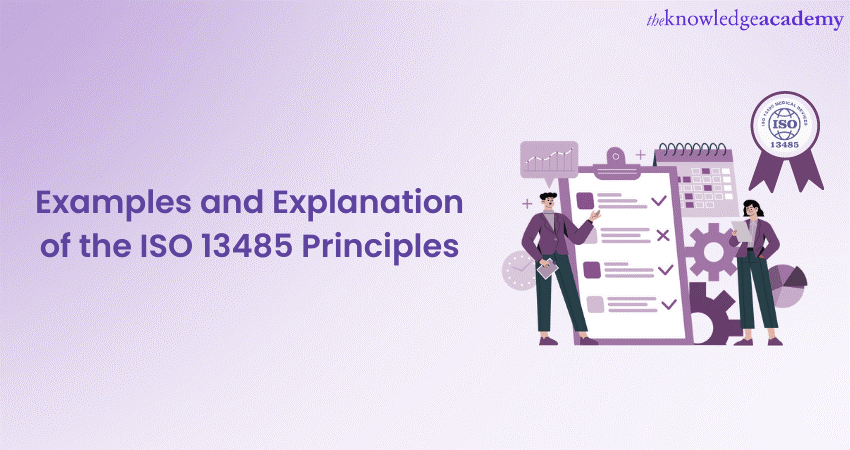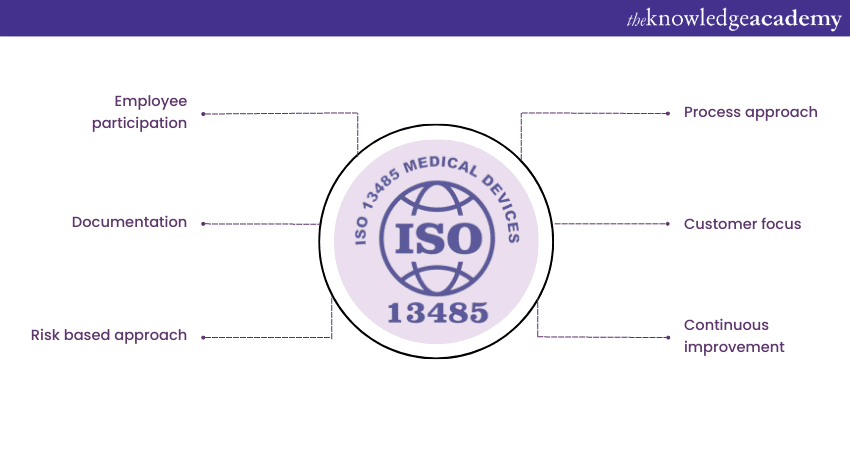We may not have the course you’re looking for. If you enquire or give us a call on 01344203999 and speak to our training experts, we may still be able to help with your training requirements.
Training Outcomes Within Your Budget!
We ensure quality, budget-alignment, and timely delivery by our expert instructors.

ISO 13485 is a globally recognised standard for Quality Management Systems (QMS) for the medical device industry. To successfully implement this standard, understanding the ISO 13485 Principles is essential. These help you follow the standards and ensure medical devices' safety, effectiveness, and regulatory compliance.
This blog will explore the fundamental ISO 13485 Principles, examples, and explanations for each principle. Understanding these will help organisations establish and maintain a robust quality management system for their medical devices.
Table of Contents
1) ISO 13485 Principles
a) Focus on customer
b) Employee participation and involvement
c) Adopting a process approach
d) Risk-based approach to decision making
e) Striving for continuous improvement
f) Documentation and records
2) Conclusion
ISO 13485 Principles

ISO 13485 is an international standard that specifies the requirements for a quality management system in the medical device industry. It outlines the principles that organizations should follow to ensure the safety and effectiveness of their medical devices.
Learn all the fundamental knowledge about the ISO 13485 standards and become familiar with stages of ISO frameworks and process mapping with ISO 13485 Foundation training.
Focus on customer
The first ISO 13485 Principle is about being customer oriented. This means that organisations must understand and meet the requirements and expectations of their customers, including patients, healthcare professionals, and regulatory bodies.
By placing the customer at the centre of the quality management system, organisations can deliver products that meet their needs and improve patient safety, trust, and satisfaction. Understanding customer requirements allows organisations to align their processes, resources, and strategies accordingly.
Example: Suppose a medical device manufacturer produces a new diagnostic device. The manufacturer conducts market research and engages with potential customers to identify their needs and expectations. This enables the manufacturer to ensure that the device is user-friendly, accurate, and reliable, catering to the actual needs and requirements of the end-users.
Employee participation and involvement
ISO 13485 emphasises the importance of employee participation and involvement in achieving the organisation's quality objectives. It recognises that employees are a valuable resource and encourages their active contribution to the quality management system.
Organisations can tap into their expertise, ideas, and insights by involving employees at all levels. This fosters a culture of ownership and responsibility, leading to better decision-making, increased efficiency, and enhanced quality throughout the organisation.
Example: A medical device company can establish cross-functional teams involving employees from various departments, including design, manufacturing, quality assurance, and regulatory affairs. Such a team can collaborate to identify and address quality issues, share knowledge, and continuously improve processes.

Adopting a process approach
ISO 13485 emphasises the importance of adopting a process approach to quality management. This means managing activities and resources as interrelated processes to achieve the desired outcomes effectively. By understanding and controlling these processes, organisations can consistently deliver products that meet regulatory requirements and customer expectations.
Example: Let's consider the process of manufacturing a medical device. The organisation identifies and defines all the steps involved in the manufacturing process, from sourcing raw materials to final product assembly and testing. Each step is documented, and process controls are implemented to ensure consistency and adherence to quality standards. This leads the manufacturer to identify areas of improvement, streamline workflows and minimise the risks.
Risk-based approach to decision making
ISO 13485 advocates for a risk-based approach to decision-making within the quality management system. The Importance of ISO 13485 can be understood from the fact that it recognises identifying and mitigating risks is essential to ensure medical devices' safety and effectiveness and maintain compliance with regulatory requirements.
The risk-based approach systematically identifies, analyses, evaluates, and controls risks throughout the product lifecycle. It helps organisations make informed decisions by considering the potential impact of risks on product quality and patient safety.
Example: Let's consider a medical device manufacturer developing a new implantable device. Before initiating the design and development process, the manufacturer conducts a comprehensive risk assessment, considering materials, manufacturing processes, and potential hazards. Based on the assessment, they implement risk control measures to minimise or eliminate identified risks.
Become an ISO 13485 Lead Auditor and improve your career prospects with our ISO 13485 Lead Auditor training.
Striving for continuous improvement
ISO 13485 places a strong emphasis on the concept of continuous improvement within the quality management system. This principle acknowledges that organisations must constantly seek opportunities to enhance their processes, products, and overall performance to meet evolving customer expectations and regulatory requirements.
Continuous improvement involves systematically identifying, addressing, and monitoring opportunities for enhancing the quality management system. It requires a culture of learning, innovation, and a commitment to excellence. Organisations can drive efficiency, reduce costs, and enhance customer satisfaction by striving for continuous improvement.
Example: A medical device manufacturer regularly collects and analyses data from post-market surveillance, customer feedback, and internal audits. Based on this information, the manufacturer identifies areas for improvement, such as reducing product defects or streamlining manufacturing processes. The organisation then implements corrective and preventive actions to address these areas and monitors the effectiveness of these changes.
Documentation and records
ISO 13485 places significant importance on documentation and records within the quality management system. This principle emphasises the need for organisations to establish and maintain documented information to ensure effective planning, operation, control, and monitoring of their processes and activities.
Documentation is vital for maintaining consistency, communicating expectations, and demonstrating compliance within the quality management system. Records provide evidence of actions taken, decisions made, and results achieved, enabling organisations to trace and verify the effectiveness of their processes.
Example: A medical device company develops and maintains a comprehensive set of documents, including quality manuals, procedures, work instructions, and forms. These documents outline the processes, requirements, and responsibilities necessary to ensure compliance with ISO 13485.
Learn the purpose of a quality management system with our ISO 13485 Lead Implementer course. Join now!
Conclusion
We hope you enjoyed reading this explanation and examples of ISO 13485 Principles. This standard guides the application of QMS for the medical device industry. It includes customer focus, employee involvement, process approach, risk-based decision-making, continuous improvement, effective documentation and records management, thus ensuring regulatory compliance and product safety. Adhering to these enables organisations to meet customer expectations, drive efficiency, and maintain excellence in the medical device industry.
Gain the skills and knowledge you need to conduct effective internal audits of your organisation's quality management system with ISO 13485 Internal Auditor training.
Frequently Asked Questions
Upcoming Health & Safety Resources Batches & Dates
Date
 ISO 13485 Foundation
ISO 13485 Foundation
Mon 15th Jul 2024
Mon 28th Oct 2024







 Top Rated Course
Top Rated Course


 If you wish to make any changes to your course, please
If you wish to make any changes to your course, please


